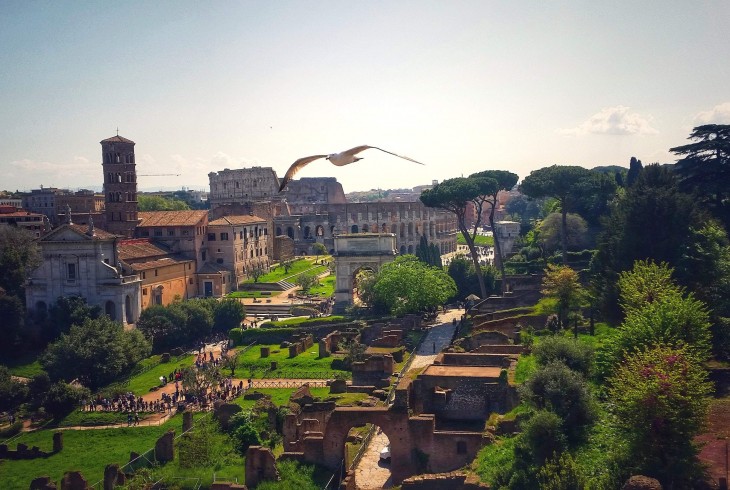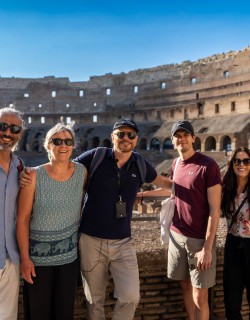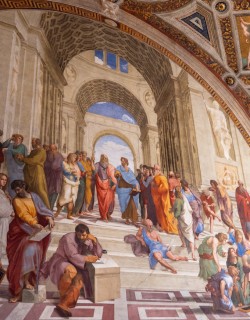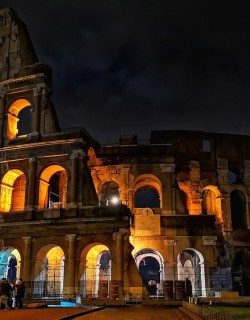While the Colosseum stands, Rome shall stand; when the Colosseum falls, Rome shall fall; when Rome falls, the world shall fall.
- The Venerable Bede
The English monk Bede fundamentally linked the fate of Rome with that of the Colosseum way back in the 8th century; luckily for us, the magnificent amphitheater is still standing, and remains the most iconic landmark in the Eternal City nearly 1,300 years after Bede penned his prophetic words.
Astonishingly massive and wonderfully evocative of the ancient culture that moved heaven and earth to construct it, when you come to the Colosseum you feel as if you can reach out and touch the distant world of antiquity across the gulf of centuries. Even though we might think we know the Colosseum all too well from world of popular culture, witnessing its endless rows of arches gleaming in the Roman sun for the first time can turn even the most jaded traveller into a child filled with wonder.
To help you plan your visit to the Colosseum, we've put together this quick guide to the history of the Colosseum. If you want to find out all the practical details you need to know about visiting the monument, then be sure to check out our detailed guide to visiting the Colosseum in 2025 here.
What exactly is the Colosseum, and where is it?
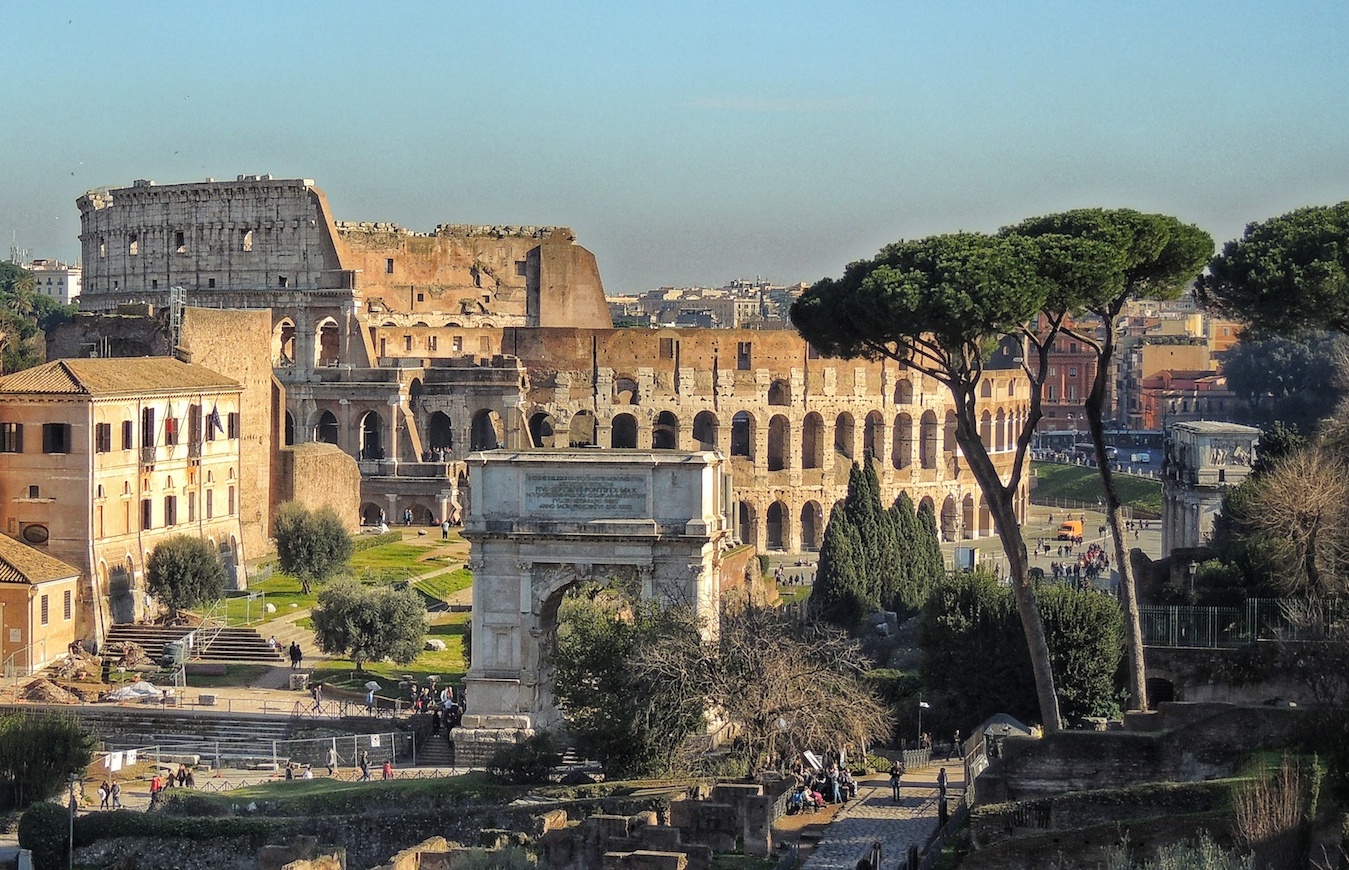 The Colosseum seen from the Roman Forum
The Colosseum seen from the Roman Forum
Like many of the most interesting things in life, the Colosseum is a paradox: as both the symbol of an incredibly advanced civilisation whose skill in engineering was centuries ahead of its time and at the same time a gore-stained monument to an insatiable collective bloodlust, a visit to the Colosseum reminds us of how ancient Rome was both eerily similar to our world and totally alien to it.
The Colosseum remains the largest amphitheatre ever built, and the most immediately recognisable icon of the ancient world nearly two millennia after its construction. The structure is visible from all over the city, and is centrally situated next to the Roman Forum and Palatine Hill, the antique centre of political power and site of the Imperial palaces respectively.
The Colosseum was designed specifically for entertainment, a place where all Roman citizens could go to let their hair down and forget about the hardships of daily life. It was begun in 70AD on the orders of the emperor Vespasian as a gift to the people of Rome and proof of his generosity. The massive stadium regularly welcomed crowds of 65,000 people and more to its events, which were open to all Roman citizens of the city (they were free, too).
To inaugurate its completion, the emperor Vespasian’s son and successor Titus celebrated with 100 days of non-stop games including exotic animal hunts, executions, music, and of course gladiator battles. The tradition of the games would continue here for fully five centuries as a key guarantor of social cohesion in the Imperial capital.
Known to antiquity as the Flavian Amphitheatre, the Colosseum only gained its current title many centuries after the games had ceased. To understand why, we have to travel back in time, back to the reign of one of the most notorious villains of Roman history: Nero.
Nero's Golden House
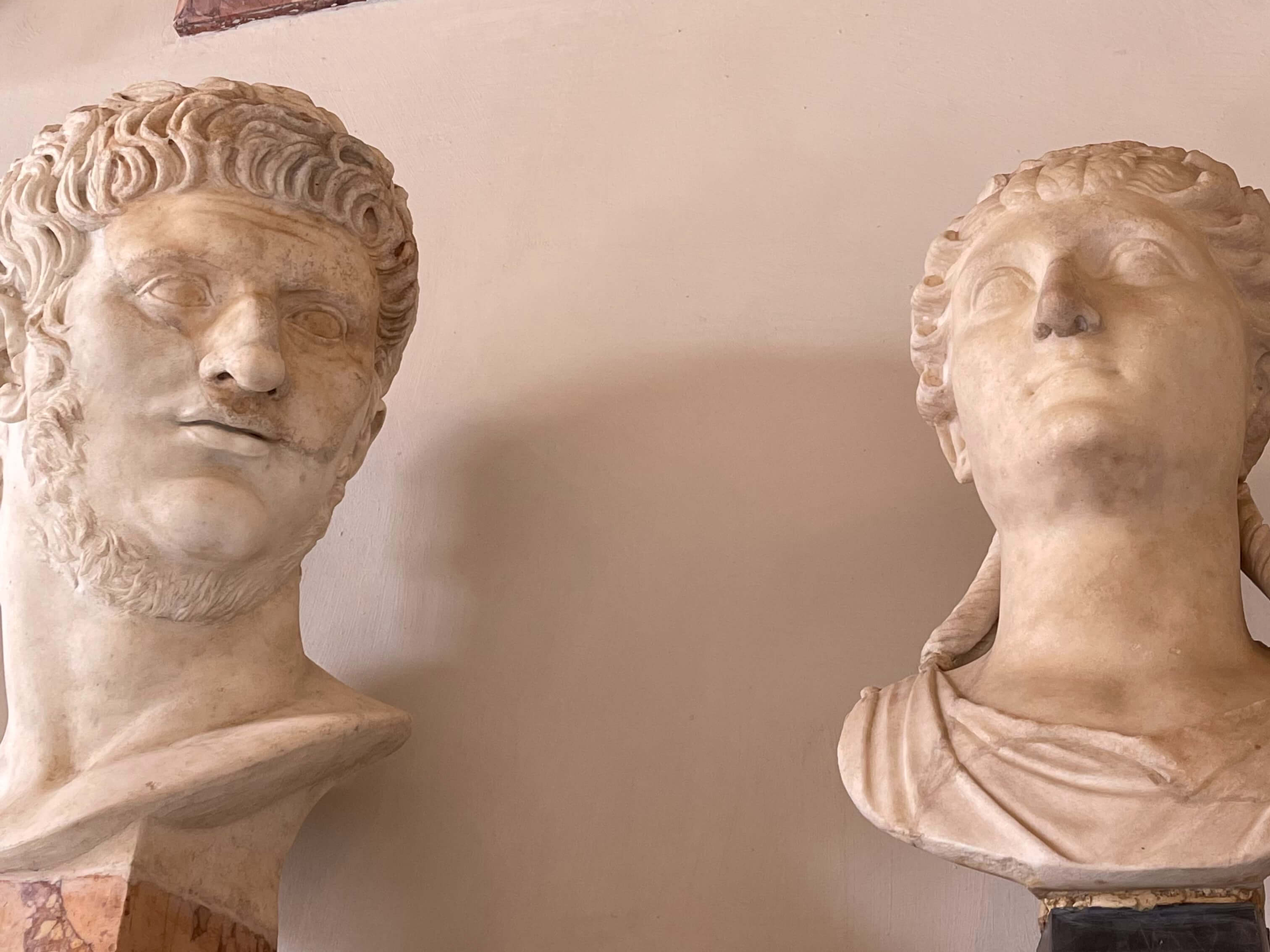 Bust of Nero in the Capitoline Museums, Rome
Bust of Nero in the Capitoline Museums, Rome
Nero is remembered to history for many things. Persecuting Christians and other minorities, fiddling cheerfully as Rome went up in flames, casually assassinating his enemies, and even ordering the murder and dissection of his own mother. The egotistical Nero was convinced both of his own divinity and his artistic genius, proud of his skills as an actor, dancer, musician and orator. His dying words reflected the esteem in which he held himself right up to his last breath - lamenting his passing, the emperor wistfully reflected ‘what an artist dies with me.’
Nero blamed the devastating fire that gutted the city in 64 AD on the mysterious and cultish Christians who were unwilling to integrate into pagan Roman society, but they were just the scapegoats. Many historians speculate that Nero started the fire himself; at the very least, he massively profited from its destruction of two-thirds of the city. Before the ashes were even cold, he began the construction of his unimaginably massive Domus Aurea, or Golden House. The palace was so massive that Nero never even succeeded in visiting all its rooms, but the emperor was content. Here, he claimed, he could finally ‘live like a human being.’
The centrepiece of this gargantuan testament to Nero’s prodigious ego was a massive artificial lake surrounded by elegant columns – in order to supply the lake with water Nero had to divert the course of the Claudian aqueduct, a vital cog in the city’s infrastructure. For good measure the emperor marked the entrance to his palace with a bewilderingly large statue of himself in bronze. All of 120 feet tall, the effigy was intended to rival the Colossus of Rhodes, one of the wonders of the ancient world.
What’s in a name? The Colossal Statue of Nero
 Plan of Nero's Golden House, with central lake and colossus. Via Wikimedia commons
Plan of Nero's Golden House, with central lake and colossus. Via Wikimedia commons
Unsurprisingly this didn’t go down too well with the populace, many of whom had been evicted from their homes to make the Domus Aurea possible. Nero didn’t get to enjoy his pleasure-palace for long. Amidst plummeting popularity ratings and whispers of insurrection, he committed suicide in 68 AD. With a single stroke, the Julio-Claudian dynasty was over.
As founder of the new Flavian dynasty, his successor Vespasian sought to make a clean break from his hated predecessor. And so the palace was pulled down and its lake drained and filled in. On the site of the private lake that so vividly symbolised the contempt Nero held for the city’s populace, Vespasian erected a fundamentally public monument, a gift to the people whose support he desperately needed if he wasn’t to go the same way as Nero.
It is more than a little ironic, then, that sometime after the fall of the Roman empire the abandoned structure started being referred to as the Colosseum in reference to the colossal statue of Nero that once stood there!
How was the Colosseum Built?
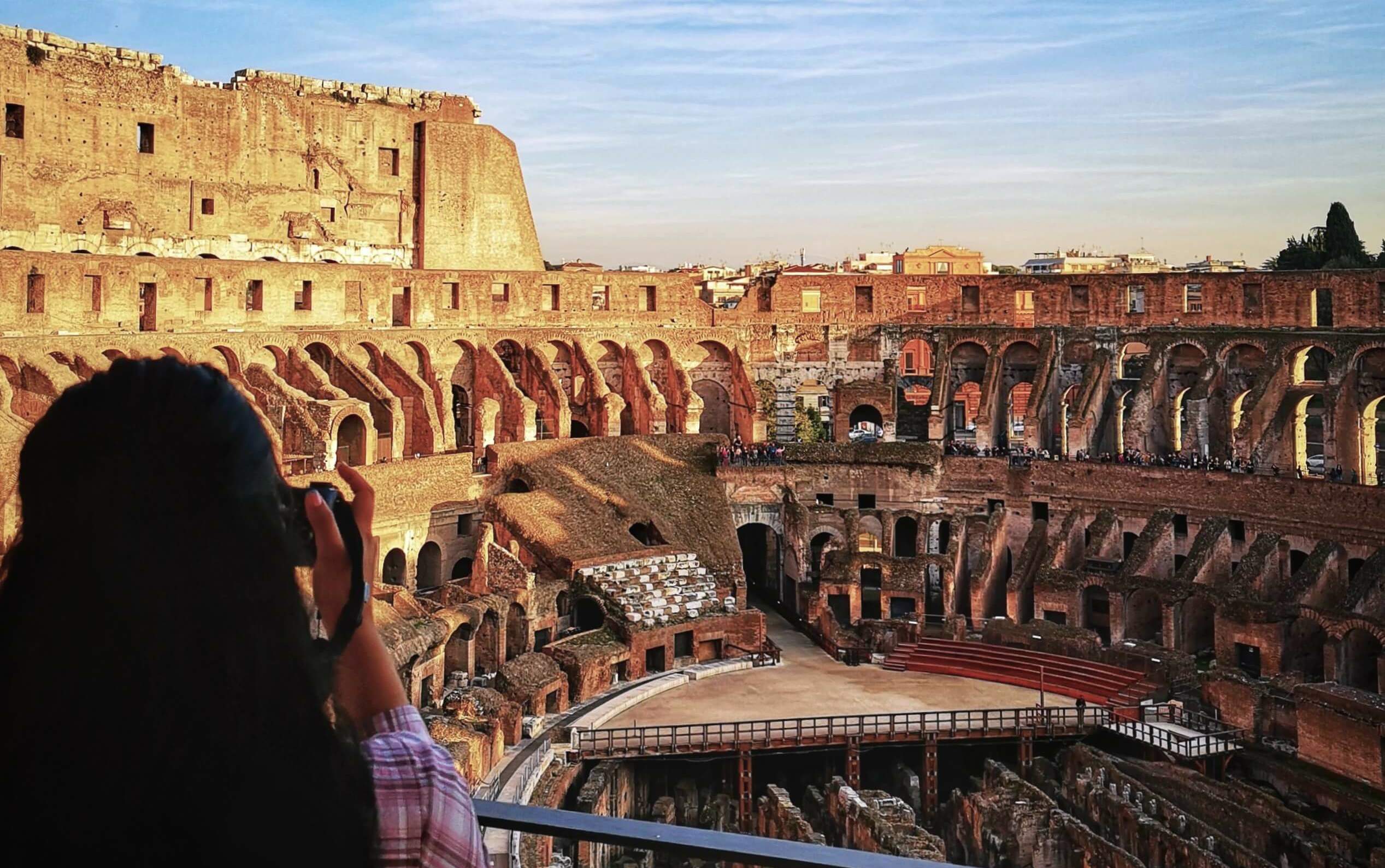 The interior of the Colosseum, seen from the upper levels
The interior of the Colosseum, seen from the upper levels
The massive oval-shaped Colosseum bucked an ancient trend for circular amphitheatres, the Roman engineers reasoning that the compressed oval shape would better provide a better view of the arena for its huge audiences. It was originally nearly 190 metres in length and 160 in breadth, and was constructed from enormous travertine stone blocks riveted together with massive iron clamps.
To construct just the exterior, 240,000 cartloads of stone were brought to the city from the quarry of Tivoli 20 miles east of Rome. Other building materials employed were tufa stone, vast amounts of masonry bricks and cement. The seats meanwhile were made from valuable and hard-wearing marble.
The façade was a design classic that was hugely influential in subsequent architectural history: arcades of travertine arches on top of each other, each framed by a different classical order of columns – Doric on the ground floor, Ionic in the middle register, and Corinthian in the upper level and attic.
Some historians maintain that four separate building contractors were each responsible for one quadrant of the building project, which was amazingly completed in just 10 years; when you consider that the great cathedrals of the medieval world often took centuries to complete, it puts the achievement of the Roman architects and engineers into perspective.
Was slave labor used at the Colosseum?
 Depiction of the Sack of the Temple in Jerusalem on the Arch of Titus
Depiction of the Sack of the Temple in Jerusalem on the Arch of Titus
Yes. The incredible speed at which the Colosseum was constructed wasn't just down to the ingenuity of Roman engineers. It is testament too to the limitless man-power that they could count on from the tens of thousands of Jewish slaves forcibly brought to Rome from Jerusalem in the wake of the Jewish Revolt in 72AD, as well as the massive cash-injection to the Imperial coffers from the riches pilfered during the Sack of that city’s temple (a pillage immortalised on the contemporaneous Arch of Titus nearby). Most likely, skilled tradesmen worked side-by-side with forced labour to bring the project to fruition.
Something to bear in mind as you explore the amazing remains of antiquity in the Eternal City: the achievements of ancient Rome were to a large degree built on the back of ruthless conquest. As a result of these dark beginnings, Rome was the first city in Europe to have a sizable Jewish population - a community that still survives to this day as an integral part of the city’s complex social fabric. Find out more about Rome's Jewish community here - A Guide to the Jewish Quarter in Rome.
What took place at the Colosseum? A Day at the Games
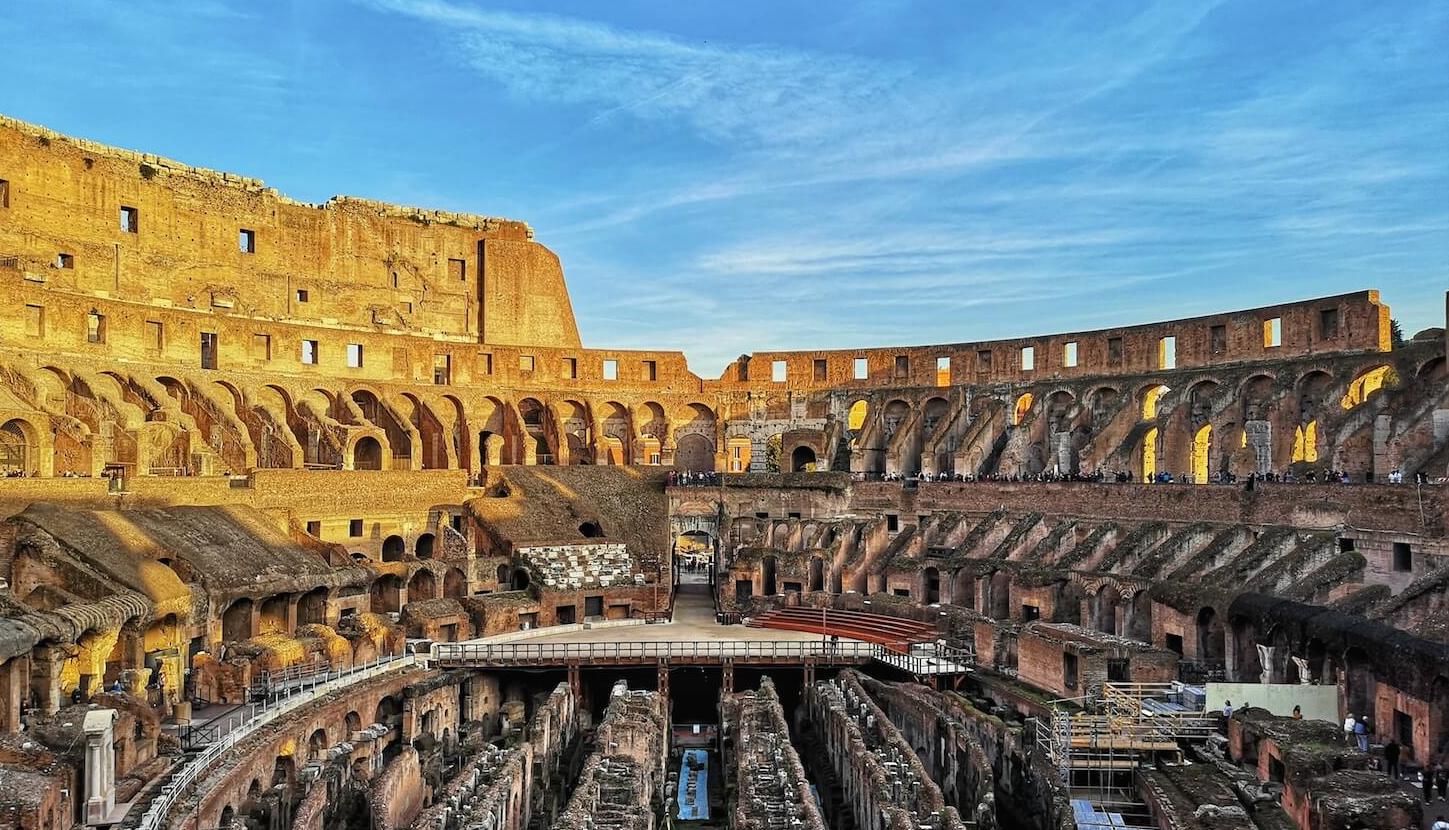
The spectacular games that took place at the Colosseum were all-singing, all-dancing propagandistic showpieces. Although gladiatorial combat and choreographed animal hunts had become increasingly popular entertainments in the Roman Empire as the Republican era reached its peak, it wasn’t until the dawn of the Imperial age that they would become the pre-eminent form of public spectacle in the ancient world.
As the democratic institutions of Rome receded in importance and power become centralised on the figure of the Emperor alone, it became increasingly important for the incumbent despot to remain in the good books of the unruly disenfranchised masses. As Russell Crowe’s Maximus puts it in Gladiator, win the crowd…
What better way to demonstrate the astonishing might of the Roman Empire and the empathetic concern of its all-powerful figurehead than free, high-octane entertainment? If TV was the 20th century’s opiate of the people, then the games were Imperial Rome’s equivalent. For the ancient satirist Juvenal, to keep the masses satisfied all you need to do was ensure a plentiful supply of panem et circenses - bread and circuses
Upcoming games were advertised well in advance, and were eagerly anticipated by the city’s populace, who probably betted on the games just as they avidly gambled on the chariot-races in the Circus Maximus. On the morning of the games spectators flooded in through 80 different entrance arches and up countless stairways and passages to their allocated seats to await the procession that marked the inauguration of the games to the sound of trumpets and fanfares. At the end of the procession out came the gladiators, the star attractions that the masses of spectators had come to see. Their turn in the arena would only come later, though.
Wild Animal Hunts
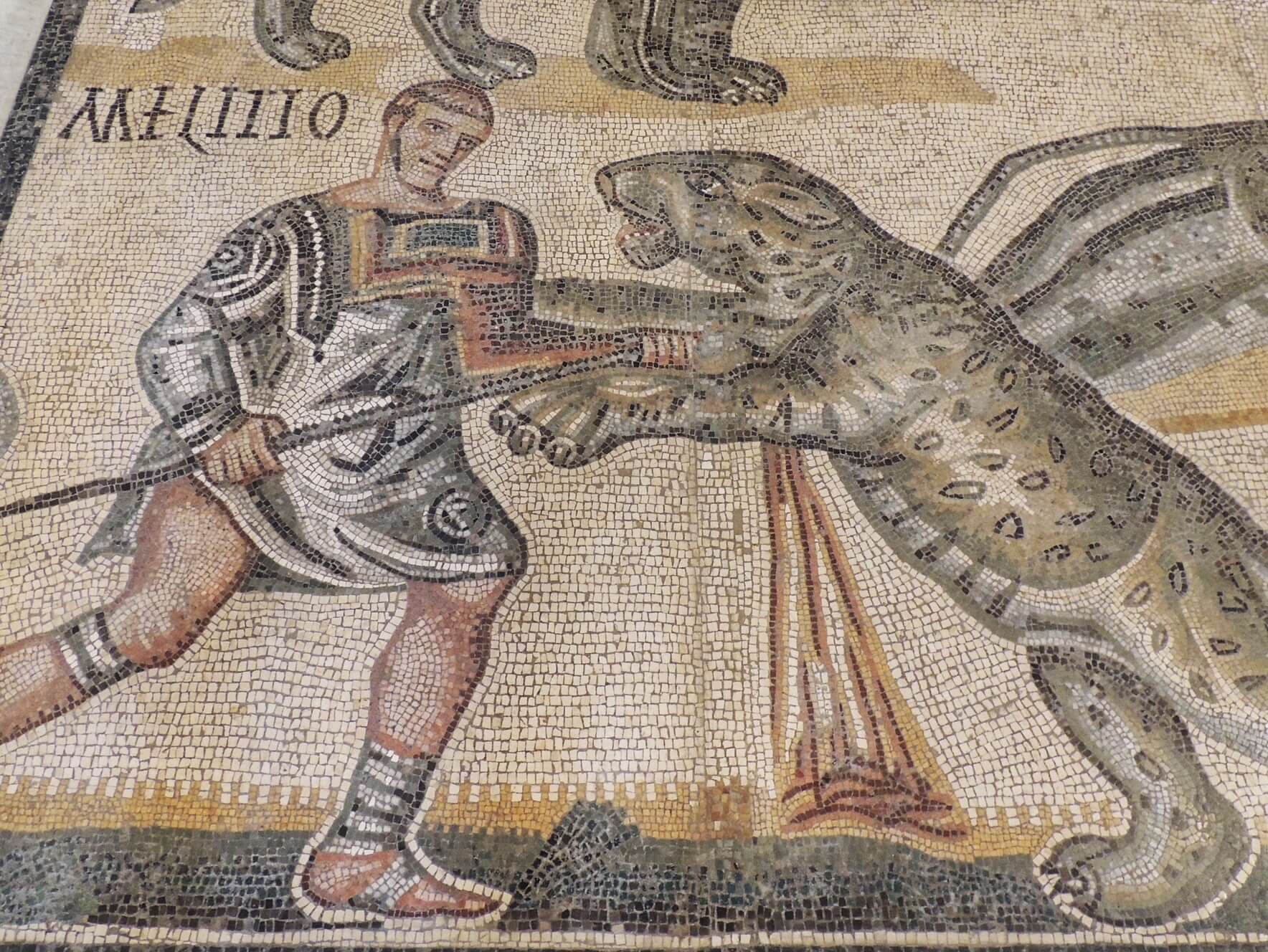 Mosaic depicting a venatio from the Villa Borghese
Mosaic depicting a venatio from the Villa Borghese
Most scholars agree that the festivities usually began with elaborate wild-animal hunts in the morning. The novel sight of exotic beasts fighting ferociously in the arena was a central feature of the festivities. Indeed, the massive-scale animal hunts that pitted the most exotic and fearsome beasts known to the ancient world against specialist hunters known as venatores were second in popularity only to the gladiator combats in the public consciousness.
All manner of animals, from ferocious lions, tigers and bears to elephants and even ostriches were slaughtered at the Colosseum. For the lowdown on these orgies of bloodletting that drove a number of species to the verge of extinction, check out our stand-alone article explaining the tradition of animal hunts in the Colosseum.
Ludi Meridiani
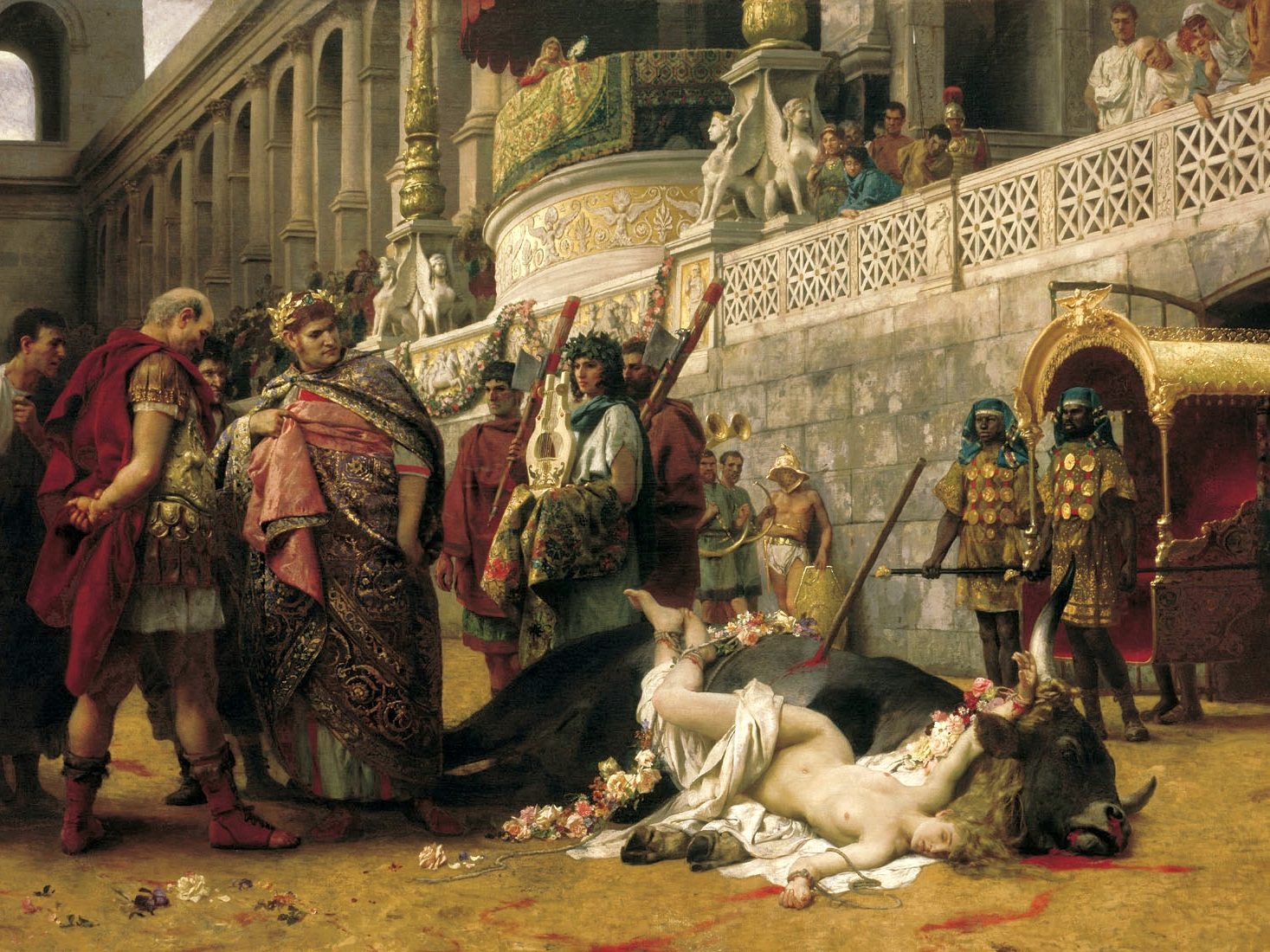 Henryk Siemiradzki, Christian Dirce, 1887
Henryk Siemiradzki, Christian Dirce, 1887
During the midday interval, the ludi meridiani took place, where condemned criminals were thrown to the surviving beasts or made to re-enact grisly ancient Greek myths, and burlesque comedies were staged to break up the rhythm of slaughter.
Those condemned to participate in these perverse stagings were forced to take on the role of tragic victims, and suffered all manner of bizarre torments; the musically inclined Orpheus, for example, was immediately recognisable to Roman audiences from the lyre he carried, and the Colosseum was transformed into a verdant woodland full of animals for his sickening star turn. Instead of charming a bear with his music as the hero does in the ancient myth, however, here Orpheus was torn apart by the disenchanted animal, with only his lyre to defend himself.
According to the Roman poet Martial these horrifying charades were a great hit with the public, and he immortalised them in a series of epigrams that provide a vivid and disquieting insight into the cruel reality of ancient Rome:
“A man offered his exposed guts to a Highland bear. / His shredded limbs clung onto life though they gushed with blood. / Finally he got the punishment he deserved…/ The criminal had surpassed all ancient folklore / Through him what had been merely myth / Became real punishment.”
Gladiator Combat
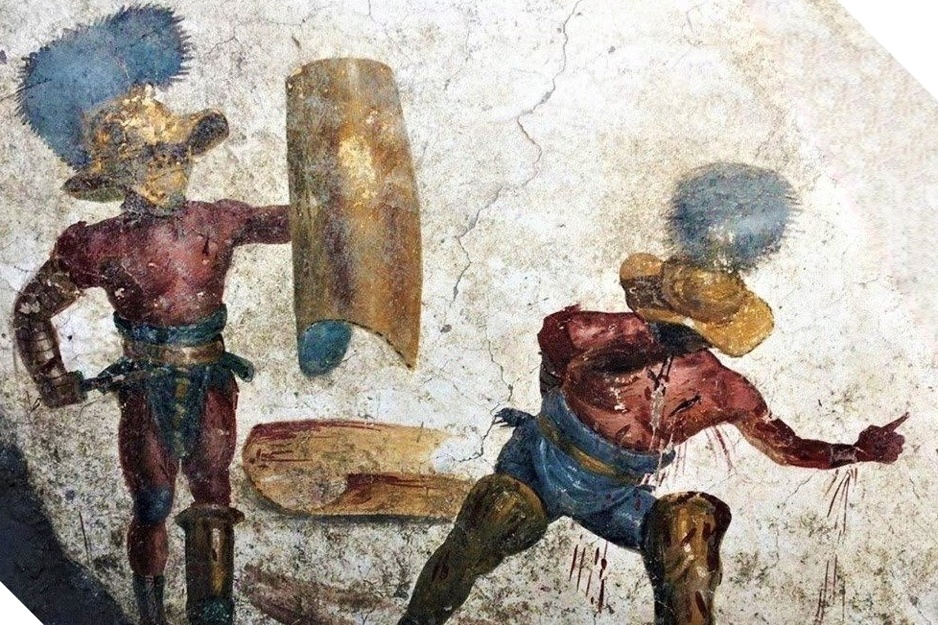 A mosaic depicting gladiator combat from Pompeii
A mosaic depicting gladiator combat from Pompeii
The climax of the day came during the afternoon, when the stage was cleared for the main event: gladiator combat. The most famous kind of entertainment that unfolded in the Colosseum was of course the gladiator battles that pitted armed combatants against one another in brutal but often highly choreographed duels to the death.
Gladiatorial combat was immensely popular during the Imperial period, and gladiators often enjoyed astonishing public acclaim. For a detailed explanation of gladiator combat in the Colosseum, including who the combatants were, how they trained, how the fights unfolded according to strict protocols and what happened to the victors and the vanquished, check out our in-depth guide to gladiators in the Roman Colosseum.
What happened to the Colosseum after the fall of the empire?
 The damaged southern facade of the Colosseum
The damaged southern facade of the Colosseum
As the empire declined it became increasingly unfeasible to maintain such a gargantuan building, and the Christian emperors of the 4th and 5th centuries were markedly less keen on gladiatorial combat than their pagan predecessors. The last known games were held in 404 AD, and blood-sports were officially prohibited in the year 438. The Colosseum was finally abandoned after a devastating earthquake in the sixth century. Some fairly inept restoration attempts failed, and the amphitheatre was left to the looters for centuries to come, who stripped it of its valuable materials and turned it into the shell.
A series of natural disasters including devastating fires and earthquakes continued to undermine the edifice over the centuries. The powerful medieval family of the Frangipani converted the abandoned amphitheatre into a residential fortress in the opening decades of the 13th century, but pope Innocent IV expropriated it for the church not long afterwards in 1244. A particularly powerful earthquake sent the southern façade tumbling in 1349, and the rubble filled site became something like a glorified quarry thereafter, its massive stones carted off for other building projects in the city.
Later, Pope Sixtus V attempted to exploit the building to kick-start the city’s economy by opening a woollen mill there to provide women with a way out of prostitution in the late-16th century, but his ambitious plans fell through.
The Christianization of the Colosseum
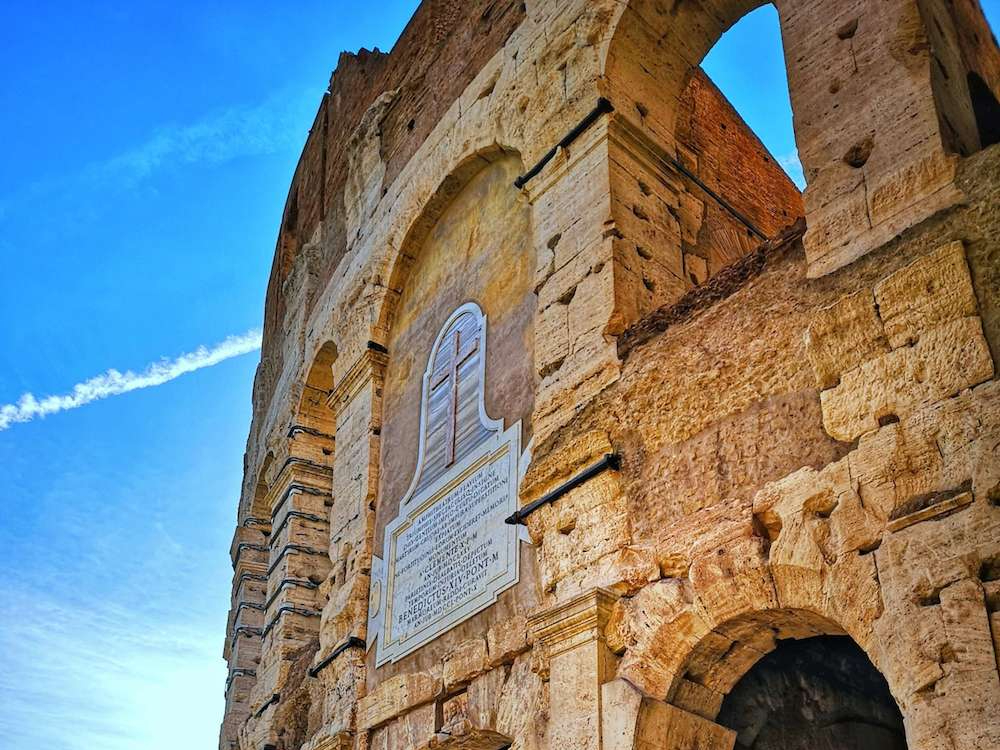 Dedicatory inscription detailing the Colosseum's consecration as a Christian site
Dedicatory inscription detailing the Colosseum's consecration as a Christian site
When you visit the Colosseum, you might wonder what’s going on with the cross and accompanying inscription attached to the eastern wall of the ancient amphitheatre. The plaque was installed by Pope Benedict XIV in 1750, and explains how 'the Flavian Amphitheatre, famed for its triumphs and spectacles, dedicated to the gods of the pagans in unholy cult, was purified from foul superstition by the blood of martyrs.’
This referenced the common belief that the Colosseum was a regular venue for Christian persecution in the ancient empire. Although persecution was a fact of life for early Christian communities in Rome, whether they were actually tossed to starving lions on the sands of the arena is widely questioned by historians. Still, we should be grateful for these early-modern embellishments - the survival of the Colosseum in such good condition owes much to its consecration as a holy site by Benedict’s predecessor Clement X back in 1675.
As with so many other pagan buildings in Rome - most famously the Pantheon - the Christianization of the Colosseum paradoxically ultimately proved its salvation, protecting it from further looting and damage and ensuring progressive restorations over the coming centuries. .
How to Visit the Colosseum
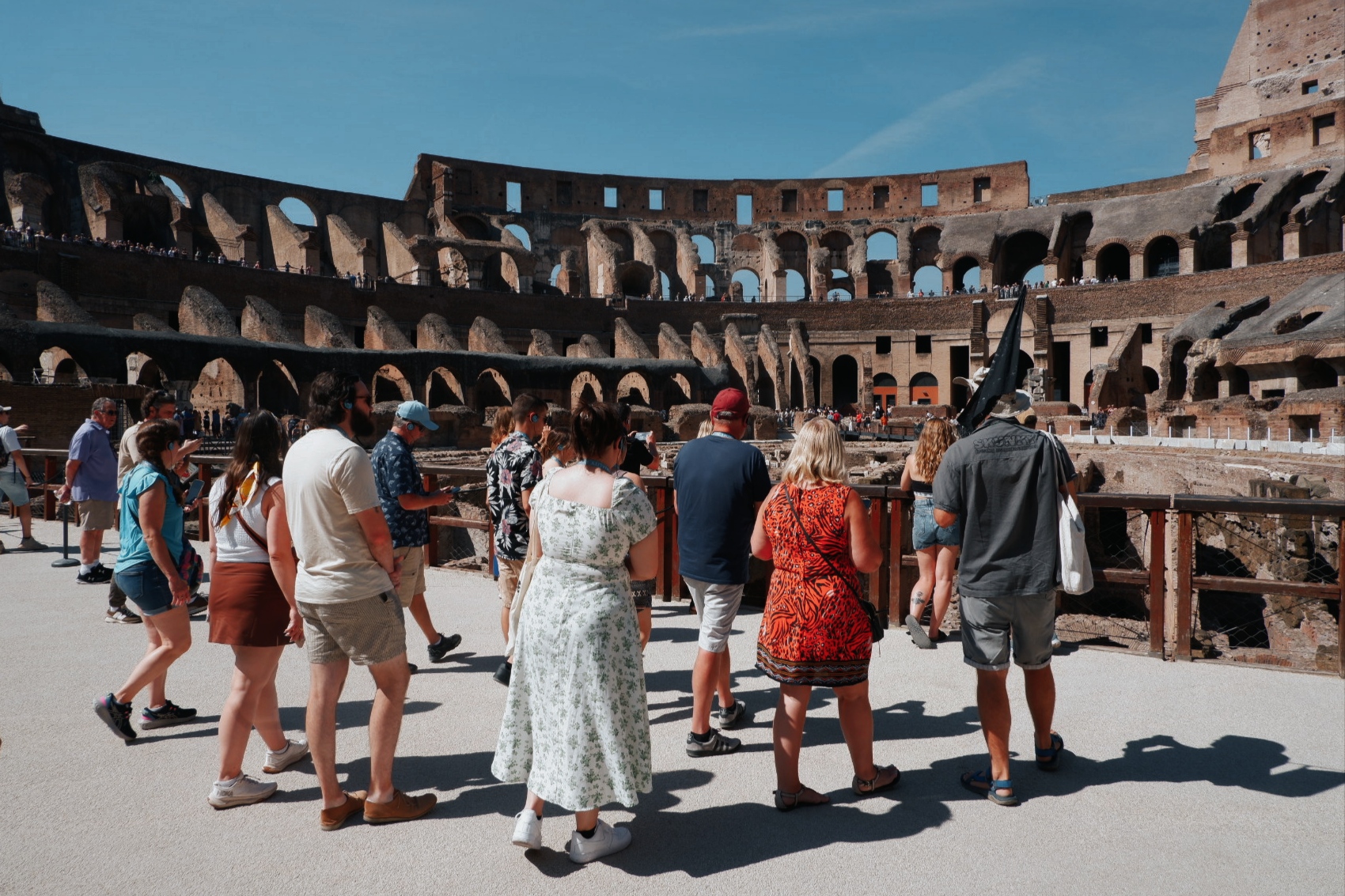 The best way to visit the Colosseum is on an expert guided tour!
The best way to visit the Colosseum is on an expert guided tour!
The Colosseum sees almost 10 million visitors pass through its gates every year, and with a dizzying variety of ticket options as well as constantly changing rules and regulations, it can feel overwhelming to figure out the best way to visit. We think a guided tour is the way to go. For a detailed breakdown, including ticket options, how to book and when to visit, check out our detailed guide to visiting the Colosseum in 2025.
We hope you enjoyed our express online guide to the Colosseum! For over 25 years, Through Eternity have been organizing expert-led tours to the Colosseum and Ancient City. If you're planning a visit to the Eternal City, check out our range of Colosseum itineraries here!
MORE GREAT CONTENT FROM THE BLOG:
- How to Visit the Colosseum in 2024
- Gladiators in the Colosseum: An Introduction
- Did the Colosseum Have a Roof?
- 5 Fascinating Facts About the Colosseum's Arena Floor
- The Colosseum Underground: The Deadliest Show on Earth
- The Best New Tours of Italy in 2024
- Where to Stay in Rome in 2024: Areas and Hotels Guide
